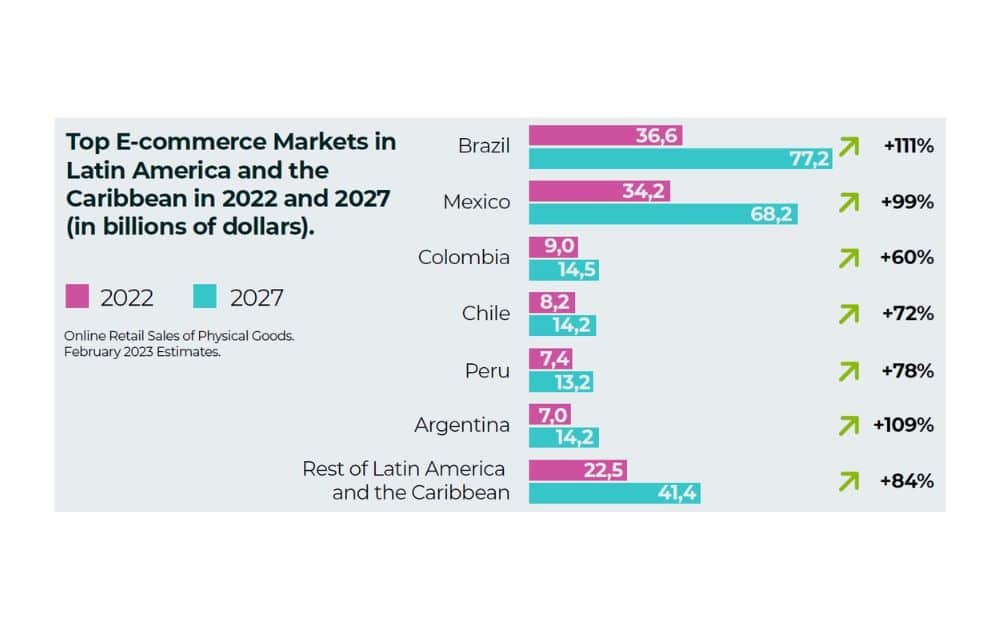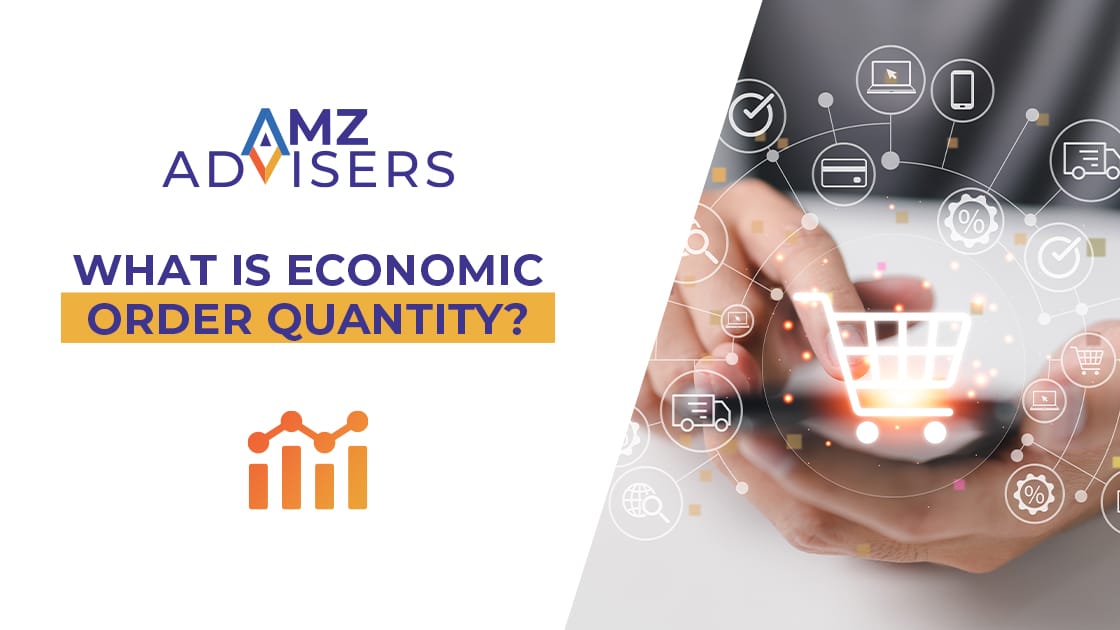Canada, Mexico, and Brazil offer great promise for Amazon sellers in the US who are looking to expand their business. Fortunately, penetrating these markets is made more efficient with Amazon Remote Fulfillment.
But why exactly should one consider the opportunity? The answer is simple ― growth. For one, Mexico and Canada are among the top countries with ecommerce as a percentage of retail sales, as per data cited by Oberlo.

In addition to that, Brazil and Mexico are the top two ecommerce markets in Latin America, and both markets are expected to increase significantly by 2027.

Let’s discuss what Amazon Remote Fulfillment is all about, and explore how you can take advantage of it to expand your ecommerce venture. We’ll also tackle tips to keep in mind when designing a fulfillment strategy.
What is Amazon Remote Fulfillment?
Amazon Remote Fulfillment is part of Amazon FBA. It’s designed to help sellers expand their reach into international markets sans the logistical hassle that typically comes with cross-border sales.
In particular, the North American Remote Fulfillment program (NARF) is the implementation of Remote Fulfillment with FBA focused on enabling sellers in the US to sell across its borders.
How Does Amazon Remote Fulfillment Work?
Amazon Remote Fulfillment allows you to sell to customers on Amazon Canada (Amazon.ca), Amazon Mexico (Amazon.com.mx), and Amazon Brazil (Amazon.com.br).
The key is that you don’t have to ship your inventory to these nations. When someone from these marketplaces orders a product, Amazon leverages the stock you have in US fulfillment centers to fulfill orders.
In short, Amazon Remote Fulfillment offers a way to sell outside the US without dealing with cross-border exportation, taxes, logistics, and other tedious arrangements.
Here’s a step-by-step guide on how the program makes expansion beyond the US easier for an international seller on Amazon:
- Enroll in the Remote Fulfillment via the FBA program.
- Use Amazon’s Build International Listings tool to have your listings duplicated and translated in the marketplace/s you choose.
- Amazon will employ the net earnings to dynamically adjust your pricing for the intended market.
- Your FBA listings from Amazon US will be accessible to customers on their local marketplaces – be it in Canada, Brazil or Mexico.
- Amazon takes charge of delivering your products directly to international customers.
- Customer support for your international orders will also be handled by Amazon.

Amazon Remote Fulfillment Fees
Products sold via Amazon Remote Fulfillment will incur two distinct charges, similar to any FBA item sold domestically. These are:
- Remote Fulfillment via FBA charge (replacing the domestic FBA fee.)
- Marketplace-specific category commission fee where the sale takes place (replacing the domestic referral fee.)
Customers will cover the cost of the product, along with any import duties and taxes on their purchases. Additionally, non-Prime customers will be responsible for delivery charges.
Amazon Remote Fulfillment vs. Amazon Global Selling
If you’ve been researching about expanding your business abroad, you’ve probably come across Amazon’s Global Selling program.
In a nutshell, the program enables sellers to list and sell their products on Amazon’s various international marketplaces, including marketplaces in Europe, Asia-Pacific, Middle-East, and the Americas.
Here are a few key differences between the two to help you decide whether you should consider NARF or Global Selling:
Amazon Remote Fulfillment |
Amazon Global Selling |
Operational Complexity |
|
| Offers a simpler, more streamlined way to access international markets using existing inventory. | Requires a more detailed approach, involving direct engagement with multiple marketplaces and potentially more complex logistics management. |
Market Access and Control |
|
| Limits sellers to certain markets based on Amazon’s fulfillment capabilities, but it requires less effort to manage. | Global Selling Provides broader access to international customers, but requires more extensive knowledge of each market and compliance with its regulations. |
Strategy and Scale |
|
| Suits sellers looking for an easy way to extend their market reach with minimal changes to their current operations. | Aimed at sellers seeking to establish a significant presence across various international Amazon marketplaces, ready to invest in the complexities of global ecommerce. |
Understanding “Pending Remote Fulfillment”
When you come across the term Pending Remote Fulfillment in the context of Amazon’s fulfillment services, it refers to a specific status in the order processing cycle.
This status indicates that an order placed through Amazon’s Remote Fulfillment program is currently in the queue for processing but has not yet been dispatched or completed.
There are several reasons why an order might be marked as Pending Remote Fulfillment:
- Processing Time. The order is being prepared for shipment. This includes picking the item from the inventory, packing, and preparing it for dispatch.
- Customs and Documentation. For international shipments, especially under programs like Remote Fulfillment, there might be additional checks for customs documentation or compliance with international shipping regulations.
- Inventory Checks. If there’s a discrepancy between the ordered item and the available inventory, or if additional verification of the inventory is needed, the order might remain in a pending state until resolved.
- Logistics Coordination. Coordinating international shipments involves various logistics partners and carriers. Sometimes, delays in scheduling pickups or transit arrangements can cause orders to be pending.
- Payment Verification. Amazon may also be verifying payment details or awaiting payment authorization, which can delay the order’s progression to fulfillment.
Designing a Remote Fulfillment Strategy
Here are a few tips to effectively implement Remote Fulfillment or marketplace expansion as an Amazon Seller:
Optimize Product Listings for International Markets
It goes without saying that your product listings must resonate with your audiences. That said, it’s crucial to tailor your product listings to appeal to each customer segment. You can do so by considering each audience segment’s:
- Local language
- Cultural nuances
- Search habits
- Purchase habits
That said, it’s vital to ensure your listings are fully translated and localized for each target market.
- Actionable Tip. Use Amazon’s translation services or hire professional translators to ensure your product descriptions, titles, and keywords resonate with international customers.
Implement Dynamic Pricing
International markets are subject to frequent changes in currency values, which can directly impact your profit margins. That said, you need to adjust prices based on current exchange rates to protect your earnings against adverse shifts in currency values.
Dynamic pricing allows you to stay competitive by matching or undercutting competitors’ prices where strategically beneficial.
- Actionable Tip. Make the most out of Amazon’s pricing tools to automatically adjust your prices in response to market changes, ensuring you remain competitive without constant manual adjustments.
Manage Inventory Proactively
Inventory management can be tricky, and all the more so when you’re expanding to new markets. That said, you need to forecast demand in each target market to ensure that you have sufficient stock to meet customer orders without delay.
Based on available metrics in Seller Central, establish a replenishment strategy that ensures your products are restocked in Amazon’s fulfillment centers before running low. You must also consider lead times for manufacturing and shipping to avoid gaps in availability.
- Actionable Tip. Set up inventory alerts within Amazon’s Seller Central to notify you when stock levels are low, allowing for timely restocking.
Understand and Comply with Local Regulations
Each country has its own set of regulations regarding imports, taxes, and product compliance. That said, you need to be in the know about the complex landscape of local regulations in Canada, Mexico, and Brazil if you plan to expand into these markets.
Here are a few examples of local regulations unique to these markets:
- Canada has regulations on consumer goods imports, including specific labeling and bilingual packaging requirements in English and French, along with compliance with the Canadian Consumer Product Safety Act.
- Mexico’s import regulations include specific documentation for customs, adherence to the Official Mexican Standards (NOMs) for product safety and information, and VAT obligations.
- Brazil has stringent import taxes and local certification requirements for electronics. The Brazilian Customer Protection Code also requires Portuguese translation of product information, with measurements in metric units or a metric equivalent.
- Actionable Tip. Utilize Amazon’s resources and webinars focused on compliance and regulatory requirements in your target markets.
The Bottom Line
As you embark on your Amazon Remote Fulfillment journey, remember that success in international marketplaces requires ample research and strategic planning. This knowledge and practice will allow you to evolve along with changing ecommerce trends and consumer behaviors.
Moreover, don’t forget to embrace a growth mindset that will push you to continuously learn and adapt. With the right strategies and a proper perspective, the potential for growth and success in international ecommerce is boundless.
Author
 Carla Bauto Deña is a journalist and content writer producing stories for traditional and digital media. She believes in empowering small businesses with the help of innovative solutions, such as e-commerce, digital marketing, and data analytics.
Carla Bauto Deña is a journalist and content writer producing stories for traditional and digital media. She believes in empowering small businesses with the help of innovative solutions, such as e-commerce, digital marketing, and data analytics.



